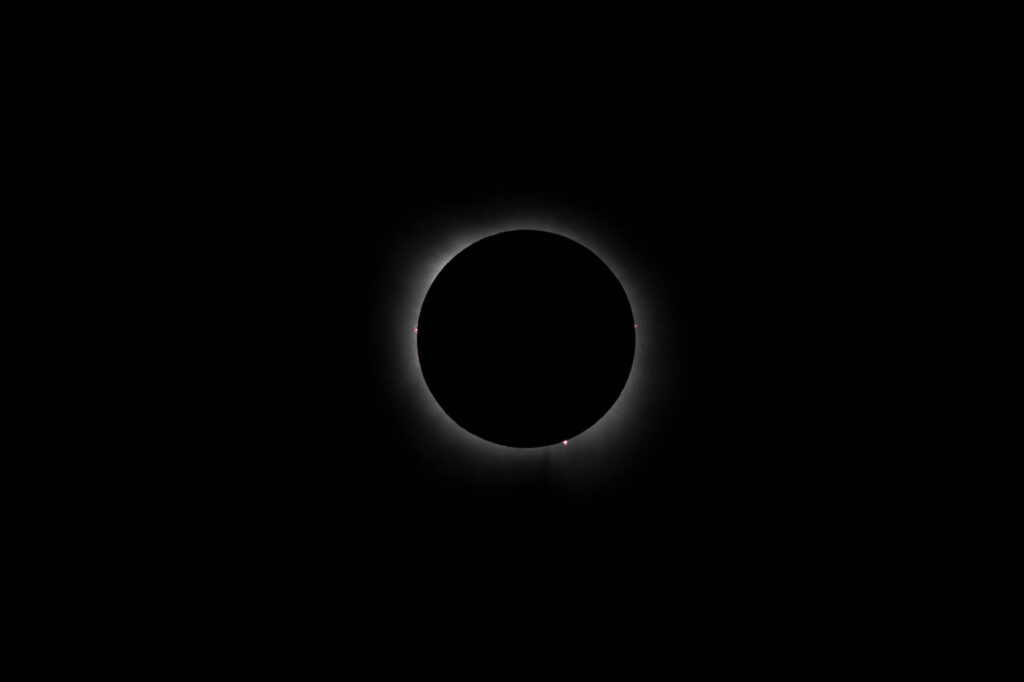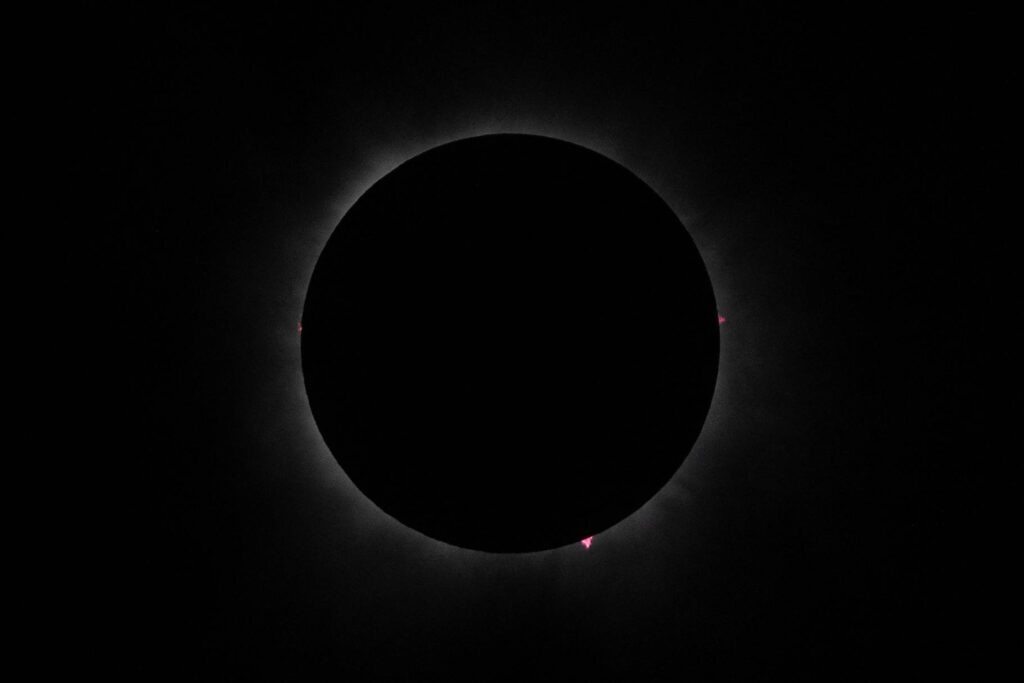The 2024 Great American Eclipse Was the Best Vacation
We may earn money or products from the companies mentioned in this post.
Let’s talk about the Great American Solar Eclipse of 2024! My aunt had previously traveled to Oregon for the Great American Eclipse of 2017 where she and many others experienced totality in a unique experience. I knew then that I wanted to experience the same thing, but it’s always a challenge traveling, especially if millions of people were going to do the same thing. In the end I made the decision. Let’s go see an eclipse!
Solar Eclipses

A total solar eclipse is when the moon blocks the sun such that only the corona is visible. The corona is the outermost layer of a star’s atmosphere and is generally not visible to the naked eye due to the brightness of the rest of the sun.
Partial solar eclipses occur when the sun is only partly occluded by the moon, which, depending on how much of the moon is obscuring the sun, may or may not have a meaningful reduction in light. This means many people may not even notice a partial solar eclipse occurring unless they were observing with proper equipment such as eclipse glasses.
Solar eclipses are different from lunar eclipses, which occur when the Earth’s shadow is cast upon the surface of the moon. By definition this can only occur at night, whereas the solar eclipse occurs during the day.

Not all solar eclipses will be a total eclipse, and having seen a partial one I wasn’t particularly impressed with what I had seen at the time. But, luckily this time there was an opportunity to spot a total solar eclipse!
Traveling For the Eclipse
I chose Austin, Texas as our destination after looking at several eclipse maps based on the desire to see totality but not travel very far as I planned on lugging along photography equipment for the event.
Time and Date’s eclipse map was very helpful in planning this out. You can check out the page for planning this last eclipse here.

The original maps that were released were later revised, with the path for totality shrinking slightly. However, if you plan on seeing totality at all, it is completely worth it to get as close to the maximum time as possible. We ended up experiencing 4 minutes and 16 seconds of totality and it went by very fast.
There will be another blog post about our travels around San Antonio and Austin, but we ultimately ended up watching the eclipse from Killeen.
Before I get to that, however, our original plan was to go to Balcones Canyonlands National Wildlife Refuge, but as the date for the eclipse loomed closer, their website updated telling us that there were now reservations and that those reservations were completely full.
With that plan smashed, we scrambled for an alternative location. We had added some friends to our travel plans and one of them found an alternative location: The LBJ Ranch.

It would be free on a first come first serve basis so we figured this would be our best bet. But as we would soon learn, our troubles were only beginning.

Crazy people and their UFOs aside, a sudden concern became the weather as many weather prediction models were forecasting clouds. Not only were there clouds, but the part of Texas we were in was predicting thunderstorms.
A new plan was needed. While we were exploring Austin, we furiously hunted on our phones for a new alternative location. That’s when we discovered an eclipse viewing party being put on by the Parks & Rec team in Killeen. It would cost $40 per car, provided hot dogs, chips, and water, and even would have bathrooms. With only 15 slots left we jumped at the registration, hoping that the weather predictions suggesting further North was better would remain true.

As we drove out to Killeen, the weather looked pretty miserable. Clouds covered the sky. But shockingly, there was no traffic on our entire trip there, aside from what seemed to be the daily commute. There were no hordes of ravaging tourists, clogging every highway artery and choking the life out of the towns.

We made it to Killeen, with the sky still grey, but significantly lighter than Austin, and made our way to the park. There was a significant police presence, but the process to get into the park was very smooth.
Although we had signed up at the last minute the night before, our names were on the list and we went in to park with no hassle at all.

We got there around 9:28am local time and the eclipse wasn’t slated to begin until 12:18pm so it was time to sit back and relax.






How to View and Photograph the Eclipse
Now on to the main event! I’ve photographed lunar eclipses before and had found them a bit challenging due to the low light levels so had an idea of what to expect but I had never shot a solar eclipse before.
First things first. Safety! When preparing for an eclipse viewing, remember that you will likely be out in the sun for a long time. Buy, apply, and wear sunscreen. Chemical, or if you are willing to help save the coral reefs, physical with something like the BLUE LIZARD SPF 30+ mineral sunscreen.

Next, protect your eyes and camera sensors. The only way to safely view a solar eclipse is with eclipse glasses. Buy several. They are cheap to purchase, and will protect your eyes. For cameras you can buy threaded lens filters for your specific lens, purchase a universal adapter, or purchase the film directly and 3d print a mount for your camera as one intrepid solar viewer did.



If you’re interested in printing your own 3D printed solar film adapter, Attenuendo has graciously uploaded 3D models for the Canon SX60 HS: https://www.printables.com/model/841815-solar-film-adapter-for-canon-sx60-hs
On to the actual viewing! As soon as the partial eclipse begins, it’s apparent fairly early on that something is going on with the sun when viewing with the glasses. As the clouds passed over the sun, however, it would disappear completely from view in our glasses.

It became a game of trying to spot the eclipse with our glasses, then quickly looking at our cameras to adjust the shot and take an image.
I tried to follow the below table for totality, but it felt like so much was going on that I didn’t have time to reference it again, requiring me to do a fair amount of editing to pull out the details for some of the different features.
| TOTAL SOLAR ECLIPSE EXPOSURE SETTING GUIDELINES | |||||
| ISO200 | |||||
| Aperture (f/stop) | |||||
| f/2.8 | f/4 | f/5.6 | f/8 | f/11 | |
| Shutter Speed | |||||
| Outer Corona | 1/4 | 1/2 | 1 sec. | 2 sec. | 4 sec. |
| Mid Corona | 1/30 | 1/15 | 1/8 | 1/4 | 1/2 |
| Inner Corona | 1/1000 | 1/500 | 1/250 | 1/125 | 1/60 |
| Diamond Ring | 1/1000 | 1/500 | 1/250 | 1/125 | 1/60 |
| Baily’s Beads | —- | 1/32,000 | 1/16,000 | 1/8000 | 1/4000 |
| Prominences | 1/16,000 | 1/8000 | 1/4000 | 1/2000 | 1/1000 |









Remember that until totality begins, the protective film on the cameras and eyes must stay in place.
And now, the moment everyone has been waiting for!
Totality
At the moment of totality, glasses and lens filters were removed, and all the watchers around us begin to cheer, then the gasps and awe began to set in. I thought everything would be pitch black, but it was a dull dusk. Looking up into the sky, it seemed like the clouds parted at the point of totality because the sun’s corona streamed through very clearly, unlike earlier in the eclipse where we waited in-between cloud cover. I wanted to see how the local wildlife was responding, but there were too many excited people exclaiming for me to tell how they might have reacted. I didn’t mind, it was amazing.








Everyone always asks, was it worth it? And I could see how that might be a justification for spending time and money to travel across the country or even the world to experience totality. I wouldn’t solely travel for an eclipse, but the experience, the shared wonder and awe that we all experienced, was most definitely worth it.
